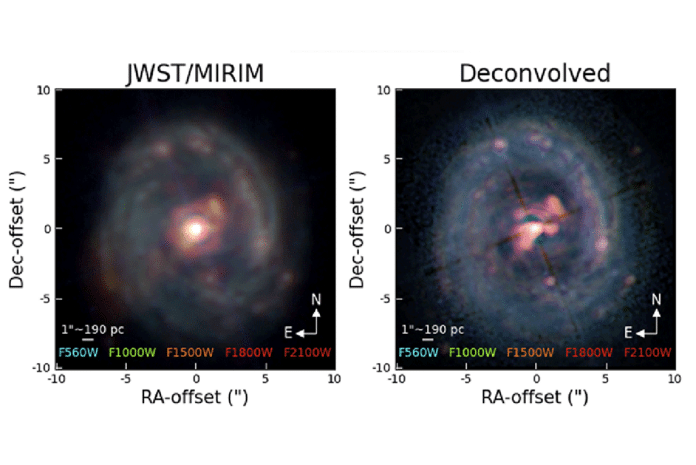The JWST’s superb image quality, stability, and sensitivity permit deconvolution techniques to be pursued with fidelity unavailable to ground-based observations. A new study assesses several deconvolution approaches to improve image quality and mitigate the complex JWST point spread function (PSF) effects.
Mason Leist, a Graduate Research Assistant at the UTSA Department of Physics and Astronomy, is working remotely, studying images of a supermassive black hole located 127 million light-years from Earth. He led a study focusing on improving pictures captured by the James Webb Space Telescope (JWST) through a mathematical technique called deconvolution.
Leist’s task was to enhance JWST observations of the galaxy NGC 5728 as part of the Galactic Activity, Torus, and Outflow Survey (GATOS), an international team of scientists co-led by his doctoral advisor, UTSA Professor Chris Packham.
The GATOS team was granted JWST time to advance its research on black holes.
Leist said, “It’s incredibly humbling. Not just working with JWST data, which is a great opportunity and a crazy amount of science, but working with our collaborators. It’s an incredible experience to collaborate with other members of the GATOS on this. I like to tell people that this work represents the efforts of 35 individuals from institutes in 14 countries.”
Mason Leist utilized deconvolution techniques to enhance simulated and observed images of an active galactic nucleus (AGN) within the galaxy NGC 5728. The AGN’s central engine, consisting of a turbulent accretion disk orbiting a supermassive black hole enveloped by a dense torus of gas and dust, plays a crucial role in the feedback mechanism between the AGN, host galaxy, and intergalactic medium.
Over two years, Leist tested five deconvolution algorithms on simulated AGN observations. Among them, the Kraken algorithm exhibited the most significant improvement in image quality for the simulated AGN model.
Subsequently, Kraken was applied to JWST observations of NGC 5728. Developed by a team at Georgia State University led by Douglas Hope and Stuart Jefferies, Kraken is a high-performance multi-frame deconvolution algorithm.
JWST observed NGC 5728 across five distinct wavelengths, revealing a faint extended feature in only one wavelength. Through Leist’s application of Kraken deconvolution, the previously unseen faint extended emission feature became visible in all wavelengths, highlighting the technique’s effectiveness in improving JWST image quality and revealing subtle extended features.
Leist said, “We believe the extension could be part of an outflow from a supermassive black hole that could interact with the host galaxy. There’s a lot more science that needs to be done. It isn’t easy to distinguish the extended structure in all JWST images. Still, using deconvolution techniques, we reduced the image data to reveal the hidden faint emission feature.”
Mason Leist’s research involved collaboration with Willie Schaefer, UTSA’s Adobe Creative Cloud support specialist. Together, they contributed to creating scientifically accurate color images for the study.
Leist’s work demonstrates the efficiency and accuracy of deconvolution as a tool for image processing. He and Professor Chris Packham suggest that similar methods can be applied to a broader range of scientific cases utilizing James Webb Space Telescope (JWST) observations.
Their approach has generated considerable interest among fellow scientists working on JWST image processing, showcasing their findings’ potential impact and applicability across the scientific community.
“We’re doing important work using JWST data,” Packham said. “But it’s important because we can improve the raw data and get better image quality to see those fainter details by using this approach. It shows the strength of collaboration within the GATOS, which is co-led from UTSA.”
Journal Reference:
- M. T. Leist, C. Packham, D. J. V. Rosario et al. Deconvolution of JWST/MIRI Images: Applications to an AGN Model and GATOS Observations of NGC 5728. The Astronomical Journal. DOI: 10.48550/arXiv.2312.14307
